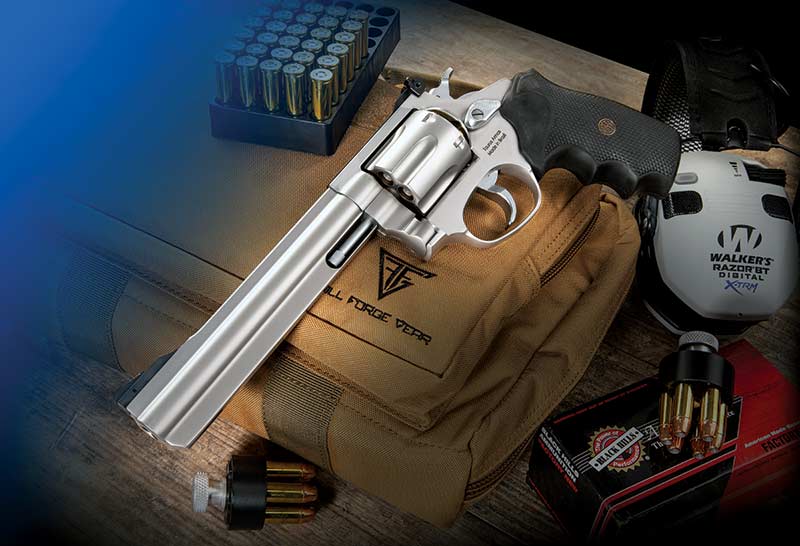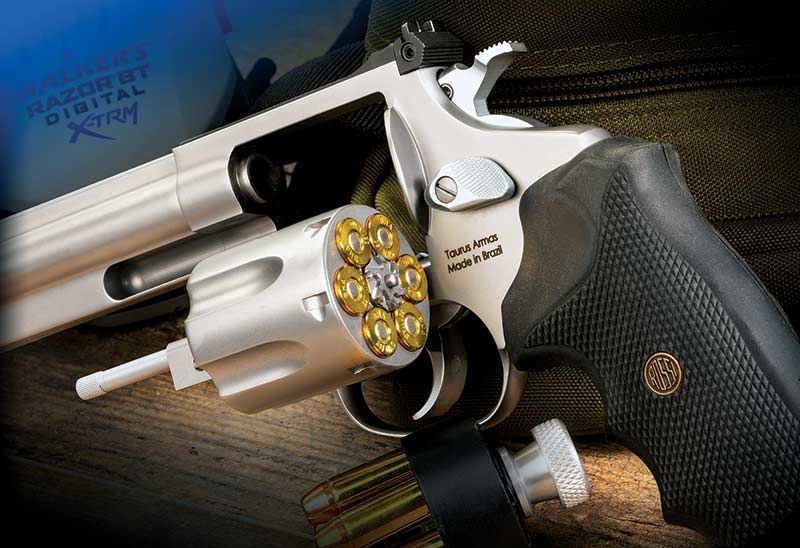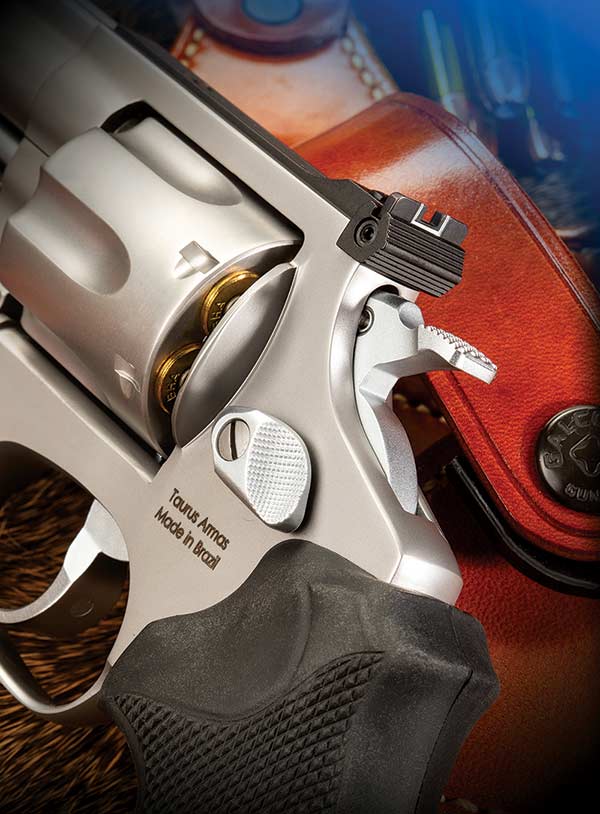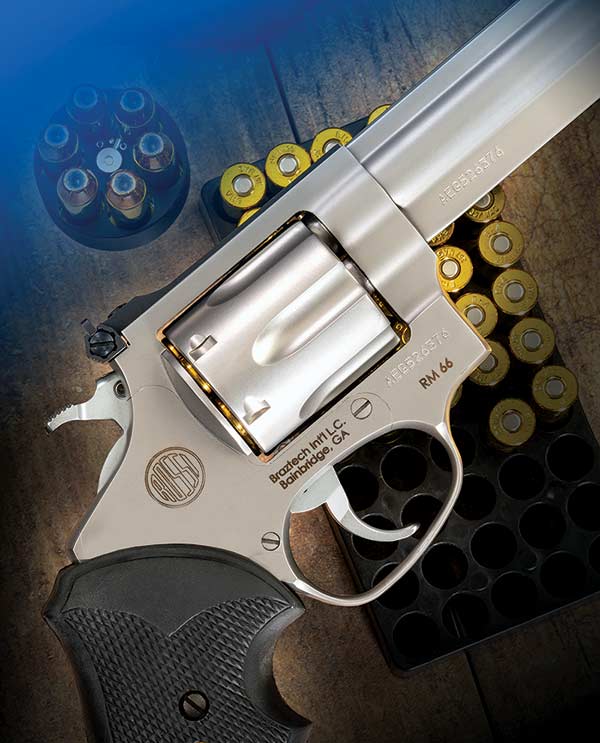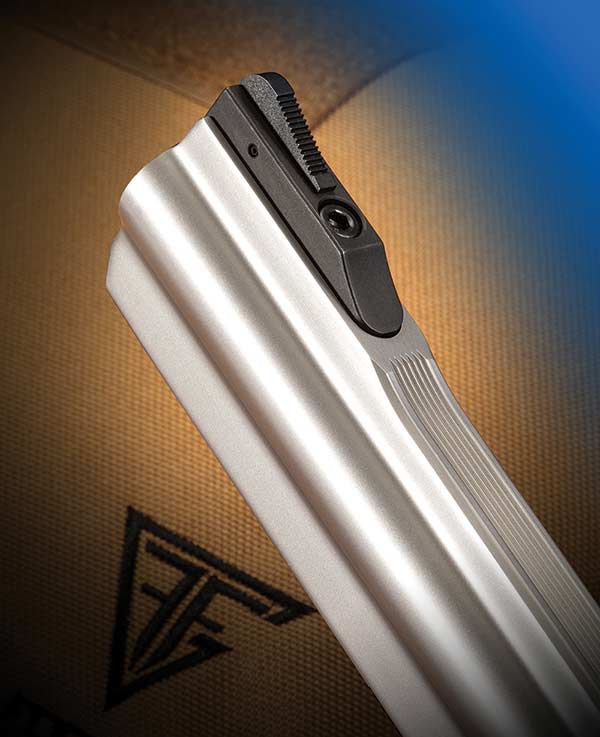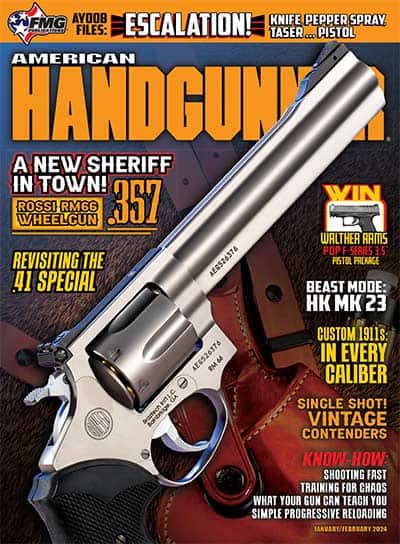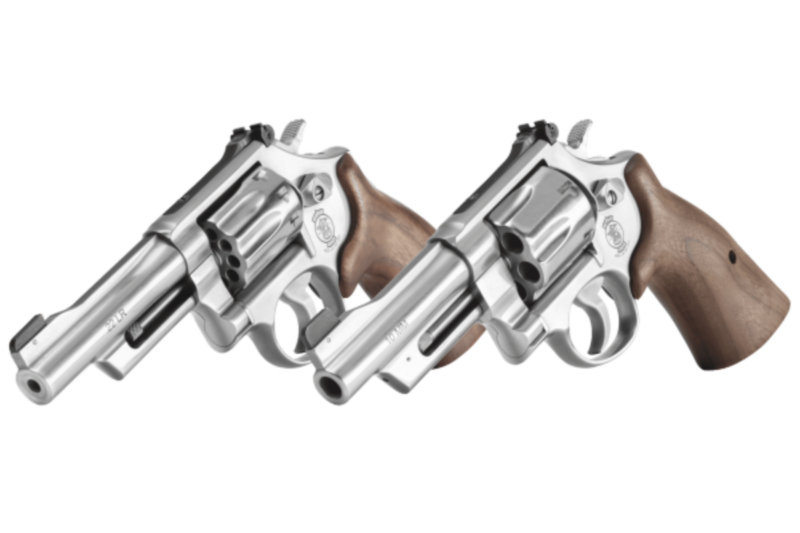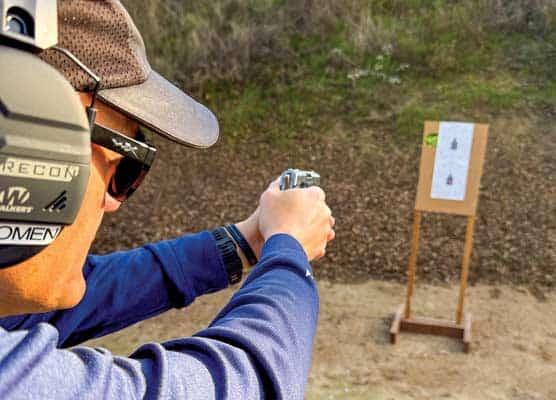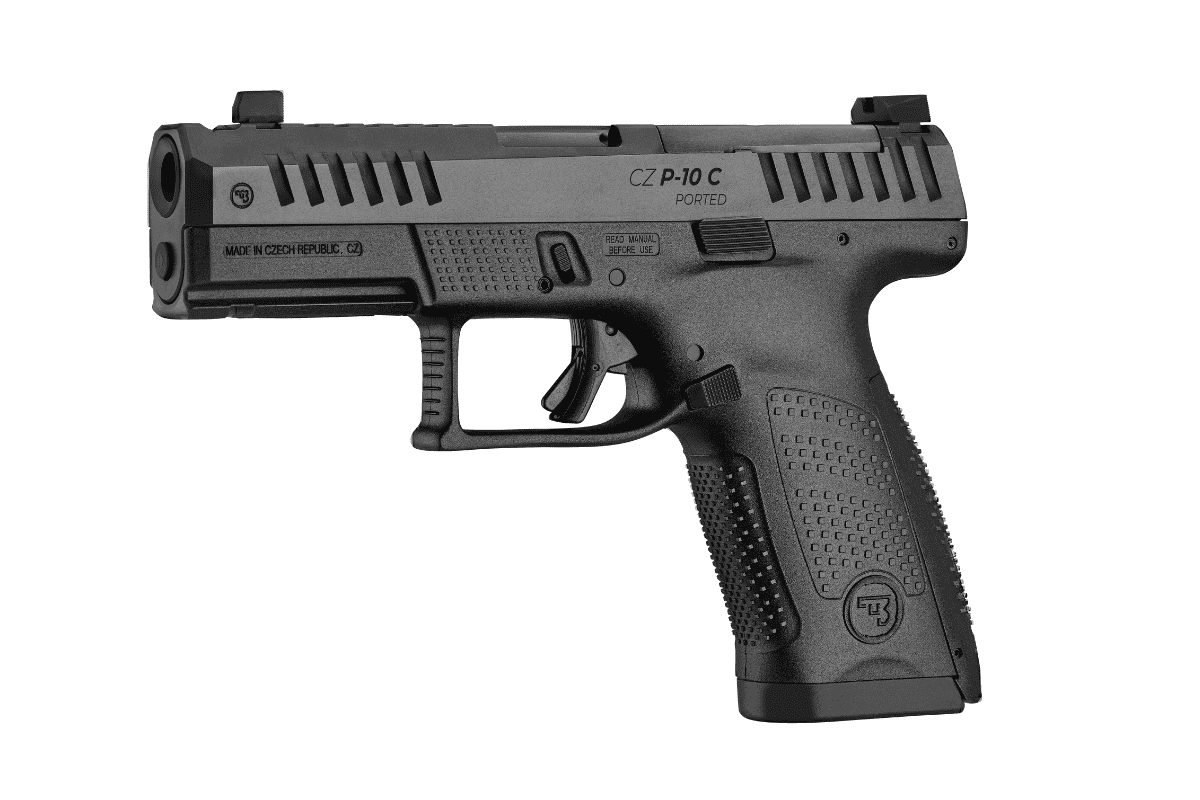Bears, Cougars & Dirtbags
Beware…There’s A New
Sheriff In Town
The Rossi USA RM66 .357 Revolver
One can argue the revolver’s ascendancy as a weapon for self-defense was eclipsed decades ago by the autoloader. As someone who finally retired his five-shot, S&W 649 snubnose .38 Special revolver for an 11-shot, Springfield Armory Hellcat 9mm, scarcely bigger, I mostly agree … mostly. In circumstances where the threat will not only kill you but eat you too, the superior reliability and stopping power of the .357 Magnum revolver trumps any autoloader. If you can handle a .41 or .44 Magnum revolver, better still, but for most folks, the .357 Magnum is a manageable compromise between power and shootability.
Value Winner
Rossi USA, which is owned by Taurus USA, released a new line of very compact, stainless steel .357 Magnum revolvers this year with 3″, 4″ and 6″ barrels and street prices under $500. I went over the 6″ adjustable sights, RM66 with a fine-tooth comb, shot the heck out of it, and concluded it performed like my S&W .357 revolvers that cost twice as much. I love my Smiths and Colts, but from a value standpoint, these new Rossi USA revolvers have them beat.
I shot this Rossi all day and found nothing I disliked. From the bench at 25 yards, there were several Magnum and .38 Special loads that delivered five-shot average groups under 2″! The pistol has a beautiful satin stainless steel finish, comfortable ergonomic stocks, a classic S&W style, adjustable, white outline, target rear sight and pinned-in, easy drawing, ramp front sight. An AmeriGlo night sight costs $30 on the Taurus USA website and is an easy DIY upgrade. Trigger pull was excellent in single-action and double-action mode, weighing 4.25 and 11.5 lbs. respectively, but feeling somewhat lighter because of the broad, smooth trigger surface.
Stocked
The rubber, semi-round butt, finger groove stocks allowed good control and painless shooting with magnum loads but were more like what you’d expect to find on a snubnose .357 than a 6″-barrel gun. Removing the stocks revealed recoil-absorbing rubber molded around a grip frame that looks just like the S&W J-Frame square-butt style used on the kit gun. I suspect you could install wooden S&W stocks by just drilling a new locating pinhole on the back side. If reducing the bulk of this already lean gun even more was your priority, that would be the way to go … at the price of some sting to your shooting hand with magnum loads.
Size & Weight
Speaking of lean, the new Rossi USA guns are the smallest, six-shot, .357 magnums around in their barrel lengths. You could say these new guns are slightly beefed-up J-Frames, heightened for a six-shot cylinder, and thickened in the front to support a full underlug barrel and heavier crane. If you are a Colt lover, you’ll be reminded of the Detective Special/Police Positive D-Frame.
The 6″ full underlug barrel RM66 weighs only 34.5 oz. My heavy barrel K-Frame S&W Model 65 seems massive by comparison and weighs a half ounce less but with two inches less barrel! As a frame of reference, the truly heavy-duty N-Frame S&W Model 27 weighs 43.2 oz. with a 4″ barrel. Of these three guns, only the N-Frame is built to handle a steady diet of .357 Magnum.
The K-Frame was intended for a lot of practice with .38 Special and duty use with magnum ammo. Since these new Rossi USA guns are lighter than a K-Frame, they can’t be expected to endure a heavier beating. That being said, Rossi USA tested the new revolver by firing 3,100 rounds of full power, 158-grain bullet, magnum loads, followed by 3,000 rounds of .38 Special +P, followed by 30,000 dry-fire cycles and found no forcing cone erosion or flame cutting of the top strap, and no degradation in accuracy, operation, or timing.
Endurance
I was really glad to learn about the endurance testing because one of my few critiques of the test gun was that the cylinder/bolt lock up, which holds each chamber in alignment with the forcing cone, while perfectly safe, was not as tight as on my pre-1990s vintage S&W and Colt revolvers. The Rossi cylinder seemed to rotate about twice as much as those premium name guns.
Marking a pencil line along the left and right extreme of the rotation, I measured it at 0.026″. I initially wondered if this was a nascent problem, but since the gun’s action can complete 36,100 cocking and firing cycles without losing its timing, I’d venture the lock-up is good enough. The perfect is the enemy of the good enough, after all, and the Rossi costs half of what the premium names do. By the way, I tracked the rotation down to the bolt itself. The slot cut for it through the frame was slightly wider than those on premium guns, allowing the bolt more room to tilt left or right on its pin.
Guts
Removing the sideplate, it was obvious the Rossi action is a near clone of the S&W. The most notable difference being the substitution of a strut-supported coil mainspring for the “V” spring. The familiar hammer block safety was also present, as was the traditional hammer-mounted firing pin. I prefer a hammer-mounted firing pin because it is simpler and hits the cartridge primer harder than the arguably safer transfer bar systems.
These new Rossi guns have a detent lock at the top of the crane that mates with a cut in the frame to help hold the front of the cylinder in alignment with the forcing cone. The Rossi also uses a shorter, solid ejector rod. While apparently not quite as rigid as the S&W style that secures the crane closed at the tip of the ejector rod under the barrel, I can see the Rossi design is less subject to damage from abuse and hard handling that might bend the S&W ejector rod, weakened as it is by the pin running through its center. Lest you vest these engineering differences with more importance than they deserve, I should point out that Colt, in the heyday of double-action revolvers, never thought it necessary to have any mechanical locking points beyond the one at the recoil shield to secure the cylinder in the frame.
In a departure from the usual, the Rossi rifling doesn’t begin where the forcing cone meets the bore as it does on most revolver barrels. Instead, the bore is smooth with a distance about equal to the thickness of the forcing cone surface, creating twice as much free bore as I’m accustomed to seeing. The company said they make them this way to accommodate longer bullet types popular with shooters outside our market. I don’t see any downside to the design, and if anything, it probably increases velocity slightly by allowing the bullet more space to accelerate before engaging the rifling … but it does look weird.
Company Lowdown
Our erudite readers may recall a class action lawsuit against Rossi some years ago that claimed some revolvers could discharge if dropped on the hammer. According to the company, they settled the suit and issued a voluntary safety warning, which is still in effect, whereby a class member could ship their revolver back to the factory, free of charge, for inspection and repair if necessary. In the meantime, the company “halted production of new revolvers and did a top-down analysis on a white sheet of paper, re-working the entire manufacturing process to ensure all new Rossi revolvers imported into the U.S. meet high standards of quality and safety.” I don’t know the exact nature of the problem, but it appears Taurus took it seriously.
Shooters in the United States, to the extent they know about Rossi revolvers, often look at them as cheap S&W knock-offs. While Rossi revolvers were always comparatively inexpensive, they are not cheap. Most of the price differential is due to the lower cost of labor in Brazil. In the United States, the Rossi brand is overshadowed in prestige by our domestic gun-making giants, but they are well-known and respected in South America. Founded by Amadeo Rossi in 1889, the company made quality guns for nearly a century before beginning business collaborations with Taurus in the late 1990s. Eventually, Taurus bought the company outright.
Today, Taurus builds Rossi revolvers in the same huge, Brazilian-based manufacturing complex as their Taurus branded revolvers, but in a separate production line. The parts for the guns aren’t interchangeable, and there are notable differences in the engineering, much of which is related to more efficient manufacturing. The Rossi models are a step above the Taurus models in finish and more traditional mechanically. Both lines use steel forgings for their frames for paramount strength. Like many premium brands, they also utilize Metal Injection Molded (MIM) parts, which greatly increases production efficiency. All Rossi USA revolvers are covered by a one-year warranty.
In summation, the Rossi USA RM66 fills a gap between J- and K-Frame .357 magnums, respectably where a compact, ultra-reliable, accurate handgun is needed. While perhaps not a gun that Cowan’s Auction will be trying to get your heirs to consign, it makes a fine EDC or working gun in the field, is well made, competitively priced, and has a DA trigger pull equal to or better than my S&W.
Subscribe To American Handgunner

Get More Revolver Content Every Week!
Sign up for the Wheelgun Wednesday newsletter here:

